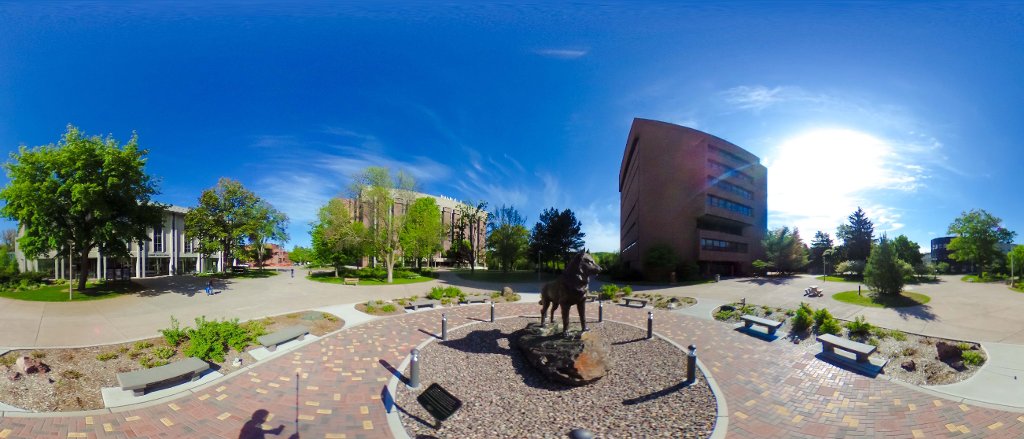The Whale Watcher
The ocean, glass smooth on the leeward side of Maui, changes from aqua to turquoise to clear navy blue as Bob Raimo and his wife, Ellen, row steadily out to sea in their seventeen-foot dory.
The small islands of Lanai and Kahoolawe loom before them, hazy in the "vog"—volcanic smog blown up from the eruption of Kilauea on Hawaii Island. Two camera bags sit unzipped between them, ready for action the moment a humpback whale spouts, slaps its tail, or otherwise makes its presence known in the 150-foot depths where they wait, small boat gently rocking, two miles from shore.
The couple, who spend most of the year in Kihei and Maui and pass their summers on a barrier island in New Jersey, row out whenever wind and sea conditions permit, which is nearly every day.
"You get addicted to the whales," says Raimo, a deeply tanned, burly man with a quietly direct way of speaking. "You just can't explain it."
Raimo, who graduated from Michigan Tech in 1979 with a BS in Forestry and a concentration in soil sciences, had no interest in either whales or photography when he first began rowing in the waters off Maui eleven years ago.
He was simply trying to stay alive and mobile—and stave off the other debilitating effects of multiple sclerosis (MS).
Raimo had always been athletic, an avid waterman. He was a surfer, a lifeguard, a member of his high school and college swim teams, a commercial clammer. When he was thirty-seven, a typical workout was swimming two miles in fifty-five minutes, five times per week. "I was in good shape," he recalls.
Then he woke up one morning blind in his right eye. Other symptoms arrived: muscle spasticity, weakness. He started falling down. Doctors were baffled, but Raimo kept seeking answers. He was finally diagnosed with multiple sclerosis, a chronic autoimmune disorder that eats away at myelin, the protective sheath that coats nerve fibers in the spinal cord and brain.
"At that time there weren't any wonder drugs to treat it," says Raimo, who was told he faced a future of growing immobility and deteriorating health. As his condition worsened, Raimo reluctantly sold his share in the thriving landscaping company he'd founded and nurtured.
"I was the president and basically had to fire myself when I got sick," he says. "It was very disappointing, because you work for years to build up a small business, and then you have to walk away."
For a time, Raimo was entirely bedridden, his MS complicated by a spinal fusion operation to repair a back injury. Then he found a good rehabilitation doctor at the University of Pennsylvania who implanted a pump that delivered a new medicine directly to his spine.
"That reduced the spasticity, and eventually I could get out of bed, into a wheelchair, and then onto crutches, so I could do more," Raimo says.
Meanwhile, Raimo and his family had moved to Maui, seeking a more laid-back lifestyle, since stress can exacerbate MS.
I've been dealing with this for eighteen years now," says Raimo, who uses crutches to nimbly navigate on land. "You kind of wait for the next little disaster to happen. But if you don't do the physical therapy, you don't get better."
So Raimo does the physical therapy: biking, swimming, hand-cycling. He can even bench press his 140-pound physical therapist, who had never witnessed such a recovery.
"He's a miracle," says Ellen, his wife of thirty-one years.
The rowing began as another way to get in shape. After finding he couldn't control a kayak because of weakness on his right side, Raimo ordered a dory from the mainland that was similar to the boat he'd piloted in rough surf as a New Jersey lifeguard, but slower and more stable.
Though entirely comfortable in the rowboat, Raimo confesses he was initially timid about sharing the water with humpbacks. After all, adults are the size of a bus, and the frolicking babies weigh two tons at birth. So for a short time he employed the marine equivalent of "bear bells," banging on the side of the boat to warn whales of their approach as he and Ellen rowed out.
Now the couple's morning workout has evolved into an exercise in patience as they wait, boat barely bobbing, for the whales to come to them.
"We sit out here for hours sometimes and don't even talk, just watch the sky," Raimo says, glancing up at the expanse of cloud-swept blue. Sometimes, they hear the whales singing, haunting intonations as audible above the water as human conversations.
"Every day is an adventure," Raimo says. One calm winter morning they were paddling out and heard the distinctive sound of big bodies hitting the water. "I told Ellen she'd better get the camera out," he recalls. "She stopped rowing, pulled the camera from the case, and three whales breached at the same time four hundred yards away. The Maui News printed that shot on the front page, and the Honolulu TV station called and used the sequence on the evening news the next night. We thought it was hilarious."
Their photography was almost an after-thought. The couple began with cheap disposables, graduating to a digital camera Raimo had bought to photograph his son's surf sessions. The big investment was a telephoto lens that allows the couple to get stunningly clear pictures from a quarter mile away. They shoot rapidly and instinctively—the animals are visible for just a second or two—and discover the day's prizes later, when poring over images downloaded on the computer.
The couple also photograph kayakers and stand-up paddlers, many of them tourists having their first encounter with a whale. They jot down email addresses and send along the pictures, a practice that has earned them friends around the world.
On the water, their unique craft confers a certain notoriety. As their dory drifts in the deep blue, other regulars—paddlers, boaters, a lifeguard—swing by to chat and share tales of recent sightings. A tour captain suggests they save themselves some work and buy a motor.
But "Rowboat Bob" and Ellen simply laugh and slip their oars into the wind-rippled sea. Moving in synchronicity, they row toward land, discussing the unpredictability of whales, weather, water, and life. "Every day is different," Raimo says. "You never know what to expect. I'm just so glad to be out here."
Michigan Technological University is a public research university founded in 1885 in Houghton, Michigan, and is home to nearly 7,500 students from more than 60 countries around the world. Consistently ranked among the best universities in the country for return on investment, Michigan’s flagship technological university offers more than 120 undergraduate and graduate degree programs in science and technology, engineering, computing, forestry, business, health professions, humanities, mathematics, social sciences, and the arts. The rural campus is situated just miles from Lake Superior in Michigan's Upper Peninsula, offering year-round opportunities for outdoor adventure.



